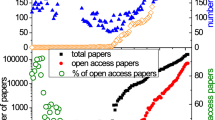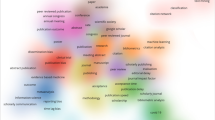Abstract
The purpose of this study was to investigate the relationship between journals" productivity and their citations in the field of semiconductors. Journal samples were gathered from the INSPEC database, 1978 to 1997 while the data of citation frequency, impact factor, cited half-life and citing half-life were obtained from Science Citation Index, Journal Citation Reports 1997 CD-ROM edition. One thousand and eight hundred and seventy seven journals publishing articles on semiconductors were retrieved. The nature for the data of journal productivity, impact factor, cited half-life and citing half-life are explored. Among these journals, only 672 journals that were covered in JCR were compared. Moreover, statistical tests of more productive journals with cumulative publication in semiconductor >100 were also conducted on the basis of all articles they published annually (for 1997). The results of the study showed that there is a significant correlation between journal productivity and citation frequency and between journal productivity and impact factor. However, there are no associations between journal productivity and cited half-life and between journal productivity and citing half-life.
Similar content being viewed by others
References
Line, M. B., Sandison, A., Obsolescence and changes in the use of literature with time, Journal of Documentation, 30 (3) (1975) 283–350.
ibid, p. 286.
SCI Journal Citation Reports, 1993, p. 10.
Lancaster, F. W., Bibliometric Methods in Assessing Productivity and Impact of Research, Bangalore: Sarada Ranganathan Endowment for Library Science, 1991, p. 20.
Gross, P. L. K., Gross, E. M., College libraries and chemical education, Science, 66 (1927) 385–389.
Magyar, G., Bibliometric analysis of a new research sub-field, Journal of Documentation, (1974) 32.
Boyce, B. R., Funk, M., Bradford's law and the selection of high quality papers, Library Resources and Technical Services, 22 (1978) 390.
Boyce, B. R., Pollens, J. S., Citation-based impact measures and Bradfordian criteria, Collection Management, 4 (1982) 29.
Lawani, S. M., Quality, Collaboration and Citations in Cancer Research: A Bibliometric Study, Ph. D diss., Florida State University, 1980.
Pontigo-Martinez, J., Lancaster, F. W., Qualitative aspects of the Bradford distribution, Scientometrics, 9 (1–2) (1986) 59–70.
ibid, p. 61.
Wallace, D. P., Bonzi, S., The relationship between journal productivity and quality, Proceedings of the American Society for Information Science, (1985) 193–196.
Brookes, B. C., Obsolescence of special library periodicals: Sampling errors and utility contours, Journal of the American Society for Information Science, 21 (1970) 320–329.
Buckland, M. K., Are obsolescence and scattering related? Journal of Documentation, 28 (1972) 242–246.
Brookes, B. C., Numerical methods of bibliographic analysis, Library Trends, 22 (1973) 34.
Ash, J., Library use of public health materials: Description and analysis, Bulletin of the Medical Library Association, 62 (1974) 95–104.
De Queiroz, G. G., Lancaster, F. W., Growth, dispersion and obsolescence of the literature-A case study from thermoluminescent dosimetry, Journal of Research Communication Studies, 2 (1981) 203–217.
Wallace, D. P., The Relationship between Journal Productivity and Obsolescence in a Subject Literature, Ph.D. diss., University of Illinois at Urbana-Champaign, 1985, p. iii.
Tsay, M.-Y., Jou, S.-J., Ma, S.-S., A bibliometric study of semiconductor literature, 1978–1997, Scientometrics, 49 (3) (2000) 491–509.
Lancaster, F. W., Vocabulary Control for Information Retrieval, 2nd ed. Arlington, VA: Information Resources, 1986.
Tsay, et al., Ref. 19.
ibid.
Subramanyam, K., Scientific and Technical Information Resources, New York: Marcel Dekker, 1981, pp. 5–6.
McCain, K. W., Turner, K., Citation context analysis and aging patterns of journal articles in molecular genetics, Scientometrics, 17 (1–2) (1989) 127–163.
Pravdic, N., Pekorori, R., The citing practices of the authors of the national journals in mathematics, physics, and chemistry, Scientometrics, 8 (1985) 233–246.
Author information
Authors and Affiliations
Rights and permissions
About this article
Cite this article
Tsay, MY., Ma, SS. The nature and relationship between the productivity of journals and their citations in semiconductor literature. Scientometrics 56, 201–222 (2003). https://doi.org/10.1023/A:1021915127459
Issue Date:
DOI: https://doi.org/10.1023/A:1021915127459




